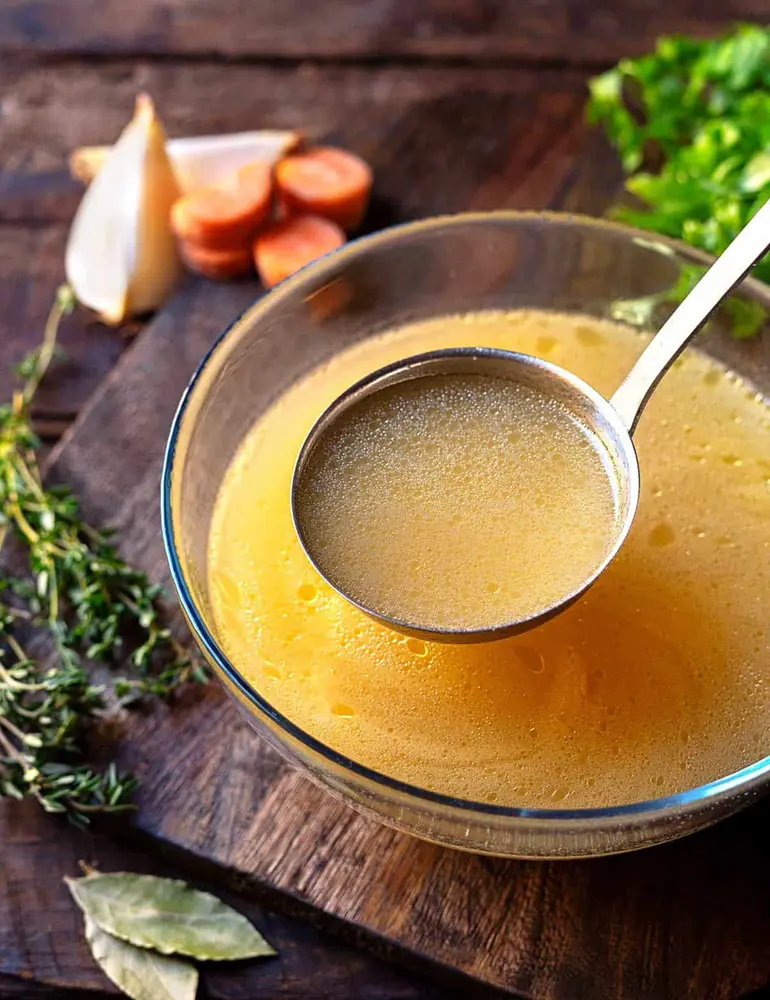Chicken Stock Recipes

Chicken stock is a cornerstone of culinary traditions around the world, celebrated for its deep flavor and versatility.
Whether you’re a seasoned chef or a home cook, mastering the art of making chicken stock is a valuable skill that enhances a variety of dishes.
This comprehensive guide covers everything you need to know about chicken stock: from the essential recipe and the best bones to use, to why certain chicken cuts are best avoided, and how to make the most out of your homemade stock.
We’ll also delve into the health benefits of this nutritious elixir.
Step-by-Step Guide to Making Chicken Stock
Ingredients:
- Bones for chicken stock: Use a combination of chicken carcasses, wings, necks, and feet for the richest flavor.
- Vegetables: Classic choices include 2 onions (quartered), 3 carrots (cut into chunks), and 3 celery stalks (cut into chunks).
- Herbs: Fresh parsley (a small bunch), thyme (a few sprigs), and 2-3 bay leaves.
- Seasonings: A few whole peppercorns (about 10) and salt to taste.
Step-by-Step Guide:

Step 1: Prepare the Bones
- Roast the Bones (Optional):
- Preheat your oven to 400°F (200°C).
- Spread the chicken bones in a single layer on a roasting pan.
- Roast the bones for 30-45 minutes, turning them occasionally, until they are browned. Roasting the bones is optional but enhances the flavor and color of the stock.
Step 2: Combine Ingredients
- Place Ingredients in Stockpot:
- In a large stockpot, place the roasted (or raw) chicken bones.
- Add the prepared vegetables: onions, carrots, and celery.
- Add the fresh herbs: parsley, thyme, and bay leaves.
- Sprinkle in the whole peppercorns.
Step 3: Add Water
- Cover Ingredients with Water:
- Pour cold water over the ingredients, enough to cover them by about 2 inches. This is approximately 12 cups (3 liters) of water.
Step 4: Simmer
- Bring to a Boil:
- Place the stockpot over medium-high heat and bring the water to a boil.
- Reduce to a Simmer:
- Once boiling, immediately reduce the heat to low to bring the stock to a gentle simmer.
- Skim Off Foam:
- As the stock begins to simmer, foam and impurities will rise to the surface. Skim off this foam with a spoon or ladle and discard it.
Step 5: Cook
- Simmer for 4-6 Hours:
- Allow the stock to simmer gently for 4-6 hours. Do not let it boil, as this can make the stock cloudy.
- Occasionally check the water level and add more water if necessary to keep the ingredients submerged.
- Stir occasionally to ensure even cooking.
Step 6: Strain
- Remove Solids:
- After simmering, remove the large solids (bones and vegetables) with tongs or a slotted spoon.
- Strain the Stock:
- Carefully pour the stock through a fine-mesh sieve or cheesecloth-lined strainer into another large pot or heatproof container. This will remove the smaller particles and result in a clear stock.
Step 7: Cool and Store
- Cool the Stock:
- Allow the strained stock to cool to room temperature. To cool it faster, place the pot in a sink filled with ice water, stirring occasionally.
- Refrigerate or Freeze:
- Once cooled, transfer the stock into airtight containers.
- Refrigerate the stock if you plan to use it within 3-4 days.
- For longer storage, freeze the stock in portion-sized containers or ice cube trays for up to 3 months. Be sure to leave some space at the top of the containers as the stock will expand when frozen.
Best Bones for Chicken Stock
Using the right bones is crucial for a flavorful and gelatinous stock. The bones provide collagen, which breaks down into gelatin during the cooking process, giving the stock its body and richness. The following types of bones are considered the best for making chicken stock:
Best Bones to Use
-
Carcasses:
- Description: Carcasses are the leftover frames from whole chickens after the meat has been removed.
- Benefit: They provide a good base for the stock, contributing both flavor and body. Carcasses typically have some meat left on them, which enhances the stock’s flavor.
- Usage: Use leftover roasted chicken carcasses for an added depth of flavor from the roasting process.
-
Wings:
- Description: Chicken wings are rich in collagen, which is essential for a good stock.
- Benefit: The high collagen content in wings adds a silky texture and depth to the stock.
- Usage: Add a handful of wings to your stockpot to boost the gelatinous quality of the stock.
-
Necks:
- Description: Chicken necks are small but packed with connective tissue and collagen.
- Benefit: Necks are often available at a lower cost and are rich in connective tissue, which breaks down to add thickness and richness to the stock.
- Usage: Include several necks in your stock for enhanced flavor and body.
-
Feet:
- Description: Chicken feet are less commonly used but are incredibly rich in collagen.
- Benefit: They are packed with collagen, which contributes significantly to a gelatinous and rich stock.
- Usage: Adding chicken feet to your stock will ensure a rich, gelatinous consistency. They are particularly effective in creating a robust stock.
Availability and Cost:
- These parts are typically cheaper and readily available, making them ideal for stock-making. Many butchers and poultry suppliers sell these parts at a low cost, especially feet and necks, which might not be in high demand for other cooking purposes.
Enhancing Flavor:
- Roasting the Bones:
- Process: Roasting the bones beforehand can significantly enhance their flavor. Preheat your oven to 400°F (200°C), spread the bones on a roasting pan, and roast for 30-45 minutes until browned.
- Benefit: This step caramelizes the natural sugars in the bones and any remaining meat, creating deeper, more complex flavors in the finished stock.
- Tip: If using carcasses, wings, necks, and feet, you can roast them together or separately, depending on your preference and oven space.
Vegetables and Herbs for Stock
Vegetables and herbs are essential for adding complexity and aroma to chicken stock. Traditional choices contribute a balance of sweetness, bitterness, and umami.
Vegetables
- Onions: Add sweetness and depth.
- Carrots: Contribute sweetness and color.
- Celery: Offers a slightly bitter, aromatic note.
- Garlic: Adds a subtle, pungent flavor (optional).
Herbs
- Parsley: Adds a fresh, slightly peppery flavor.
- Thyme: Provides an earthy, floral note.
- Bay leaves: Lend a subtle, herbal bitterness.
- Peppercorns: Infuse gentle heat and complexity.
Optional Additions
- Leeks: For a mild, sweet onion flavor.
- Parsnips: Add a touch of sweetness.
- Mushrooms: Introduce umami and depth.
What to Do with Homemade Chicken Stock

Homemade chicken stock is incredibly versatile and can be used in a variety of dishes, adding depth and richness to your culinary creations. Here are some of the most popular and delicious ways to utilize your homemade chicken stock:
Soups and Stews
-
Chicken Soup:
- A classic comfort food, chicken soup made with homemade stock is rich and flavorful. Add noodles or vegetables like carrots, celery, and onions for a hearty, nourishing meal.
-
Vegetable Soup:
- Homemade chicken stock enhances the natural flavors of fresh vegetables. It provides a savory base that elevates simple vegetable soups into satisfying, nutrient-packed dishes.
-
Stews:
- Use homemade chicken stock to add depth and complexity to hearty meat and vegetable stews. The rich, gelatinous stock improves the texture and flavor, making each bite deliciously satisfying.
Sauces and Gravies
-
Pan Sauces:
- After sautéing meats, deglaze the pan with chicken stock to create rich, flavorful sauces. The stock picks up all the browned bits (fond) left in the pan, resulting in a sauce that’s bursting with taste.
-
Gravy:
- Chicken stock is essential for making a velvety, delicious gravy. Whether for roast chicken, turkey, or other meats, a gravy made from homemade stock has a deep, savory flavor that can’t be matched by store-bought alternatives.
Cooking Grains and Legumes
-
Rice and Quinoa:
- Cooking grains like rice or quinoa in chicken stock instead of water infuses them with flavor. This simple substitution transforms ordinary side dishes into savory, satisfying components of your meal.
-
Lentils and Beans:
- Enhance the taste of lentils and beans by cooking them in chicken stock. The stock adds a subtle depth of flavor, making these protein-rich legumes even more delicious.
Braising
- Meats and Vegetables:
- Braising involves slow-cooking tougher cuts of meat or sturdy vegetables in liquid, and chicken stock is perfect for this method. The stock not only tenderizes the meat but also imparts a rich, savory flavor, resulting in succulent, flavorful dishes. Vegetables like cabbage, carrots, and potatoes absorb the stock’s flavors, making them exceptionally tasty.
Health Benefits of Chicken Stock
Chicken stock is not only a culinary staple but also offers several health benefits.
- Nutrient-Rich: Stock is packed with minerals like calcium, magnesium, and phosphorus, which are essential for bone health.
- Joint Health: The collagen and gelatin in stock support joint health by providing building blocks for cartilage.
- Digestive Health: Gelatin aids in digestion by attracting digestive juices to food, promoting a healthy gut lining.
- Immune Support: Chicken stock contains amino acids like cysteine, which can help thin mucus and support respiratory health.
- Hydration: It’s a hydrating, nourishing option, especially beneficial during illness or recovery.
- Low in Calories: Stock is low in calories but high in flavor, making it a great addition to a balanced diet.
Conclusion
Making chicken stock is a rewarding process that transforms simple ingredients into a flavorful, nutrient-rich base for countless dishes. By using bones and less desirable parts, you not only create a superior stock but also practice economical and sustainable cooking.
Whether enhancing soups, sauces, or grains, homemade chicken stock is a versatile staple in the kitchen. Beyond its culinary uses, the health benefits of chicken stock make it a valuable addition to any diet.
So, gather your ingredients, follow this guide, and enjoy the many uses and benefits of homemade chicken stock.







